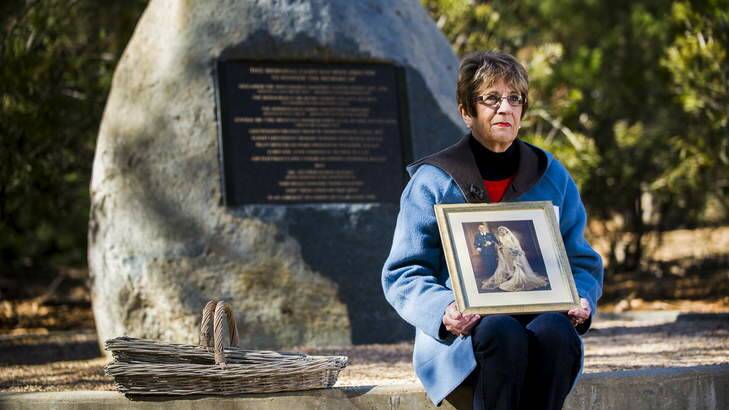A ''tragic bond'' was forged by the history shared among the dozens of people gathered at the Pialligo memorial of Canberra's worst plane disaster on Tuesday.
Subscribe now for unlimited access.
or signup to continue reading
When a Hudson bomber crashed at the site during World War II, 10 families were devastated and the course of Australian history was changed.

Kaye Greene hugged a wedding portrait of Flight Lieutenant Robert Hitchcock and her mother Olive as she bowed her head in the minute's silence.
While the pilot in charge that day in August 1940 was not her father, ''he might as well have been'' she said, having been profoundly affected by his death.

Her older half-brother was two when their mother was widowed, a fate she learnt through the radio.
''She ended up with chronic depression and when I was 13, she ended up killing herself … it affected her life dramatically, and then, of course, it affected my life,'' Mrs Greene said.
Her brother also felt the impact. ''All he ever heard was 'your father killed all these people', and that's a pretty hard thing to wear.''
John Foley's mother was also widowed, following the death of Corporal John ''Jack'' Palmer, the wireless operator. She later remarried, but never forgot. ''It's something that mum talked to me about, but couldn't share with dad - so because all of the Palmer family, I think, and my mother are dead, this is in a way my only connection with mum,'' he said.
On the plane was the minister for air, James Fairbairn; minister for the army, Geoffrey Street; minister for information, Henry Gullett; and the chief of the general staff, General Brudenell White.
The men were central to the war effort of then prime minister Robert Menzies.
''I can't imagine how awful it must have been for him,'' Mr Menzies' daughter, Heather Henderson, said. ''They were not only among his best ministers, they were all close friends.''
Also killed in the crash were Lieutenant-Colonel Francis Thornthwaite, Pilot Officer Richard Wiesener, Aircraftman Charles Crosdale and Richard Elphin, Mr Fairbairn's private secretary.
The gathering, on the 73rd anniversary of the crash, was organised by Andrew Tink, who wrote a book on the disaster.
''What happened here was a tragedy for 10 families and … a turning point in our national history, I've got no doubt about that,'' he said.
His book argued that the crash led to John Curtin becoming prime minister, and that it was probably not Flight Lieutenant Hitchcock flying the plane, but Mr Fairbairn, an accomplished pilot but untrained in flying Hudson bombers.
Mr Fairbairn's granddaughter Mary Browne said Tink's theory was not new to her, but his book also told the stories of the others on board.
''You do feel a connection between everyone here today,'' she said.

